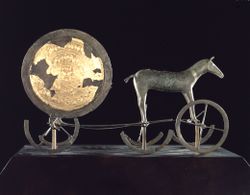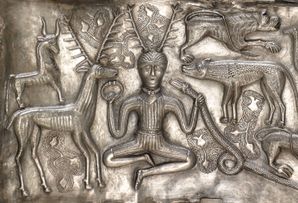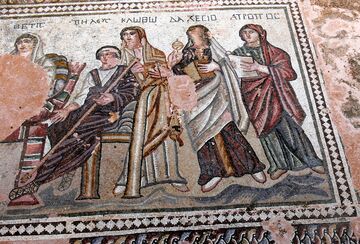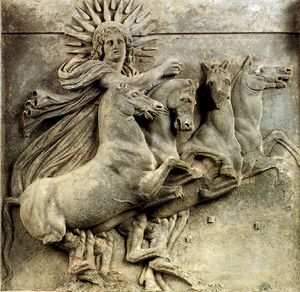الديانة الهندو-أوروپية الأولية
| جزء من سلسلة عن |
| المواضيع الهندو-أوروپية |
|---|
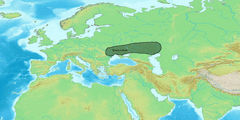 |
ديانة الهندو-أوروپيين الأوائل Proto-Indo-European religion هي نظام المعتقدات الذي كان يعتنقه الهندو-أوروپيون الأوائل. على الرغم من أن نظام المعتقدات هذا لم يُستدَل عليه بشكل مباشر، فقد أعيد بناؤه من قبل علماء الأساطير المقارنة بناءً على أوجه التشابه في أنظمة المعتقدات لمختلف الشعوب الهندو-أوروپية.
توجد مدارس فكرية مختلفة تتعلق بالطبيعة الدقيقة لديانة الهندو-أوروپيين الأوائل، والتي لا تتفق دائماً مع بعضها البعض. الأساطير الڤيدية و الأساطير الرومانية والأساطير الاسكندناڤية هي الأساطير الرئيسية المستخدمة عادةً لإعادة البناء المقارن، على الرغم من أنها غالبًا ما يتم استكمالها بأدلة داعمة من التقاليد البلطيقية والكلتية واليونانية والسلاڤية والحثية أيضًا.
ضم مجمع آلهة الهندو-أوروپيين الأوائل آلهة مؤكدة مثل *Dyḗus Pḥatḗr، إله سماء النهار، وابنته *Haéusōs، غلهة الفجر، و توائم الجيادـ وإله العواصف *Perkwunos. الآلهة المحتملة الأخرى ضمت *Péh2usōn، إله الرعاة و*Seh2ul، إلهة الشمس.
الأساطير المؤكدة للهندو-أوروپيين الأوائل بينها أسطورة تضم إله العواصف الذي يقتل حية ذات عدة رؤوس تعيش في الماء، وأسطورة عن الشمس والقمر يركبان في عربتين عبر السماء، وقصة الخلق وتضم شقيقين، يضحي أحدهما بالآخر ليخلق العالم. وربما اعتقد الهندو-أوروپيون الأوائل أن العالم الآخر كان يحرسه كلب حراسة ويمكن الوصول إليه فقط بعبور نهر. ولعلهم اعتقدوا أيضاً بشجرة العالم، التي تحمل ثمار الخلد، ويحرسها أو يتغذى بها حية أو تنين، وترعاها ثلاث آلهات هن من نسجن نسيج الحياة.
طرق إعادة البناء
المدارس الفكرية
الأساطير المصدَر
مجمع الآلهة
الآلهة السماوية
والد السماء
إلهة الفجر
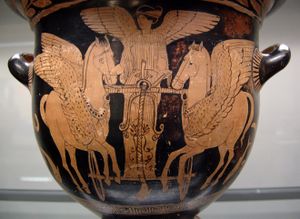
الشمس والقمر

التوائم المقدسة
الجياد التوأم
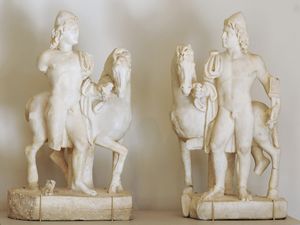
المؤسسون التوائم
The Proto-Indo-European Creation myth seems to have involved two key figures: *Manu- ("Man"; Indic Manu; Germanic Mannus) and his twin brother *Yemo- ("Twin"; Indic Yama; Germanic Ymir).[1][2] Reflexes of these two figures usually fulfill the respective roles of founder of the human race and first human to die.[1][3]
آلهة العواصف
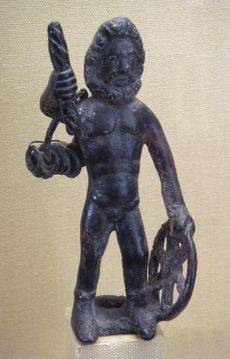
آلهة الماء
آلهة الطبيعة
*Péh2usōn, a pastoral deity, is reconstructed based on the Greek god Pan and the Vedic god Pūshān. Both deities are closely affiliated with goats and were worshipped as pastoral deities.[6]
الآلهة المجتمعية
ربات القدر
إله الرخاء
الإله الصانع
الأساطير
التنين أو الثعبان
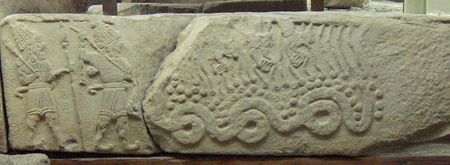
الأساطير السماوية
انظر أيضاً
- Interpretatio graeca, the comparison of Greek deities to Germanic, Roman, and Celtic deities
- Neolithic religion
- Proto-Indo-European society
Notes
المراجع
- ^ أ ب Mallory 1991.
- ^ Anthony 2007.
- ^ Lincoln 1991.
- ^ Taylor, Timothy (1992), “The Gundestrup cauldron”, Scientific American, 266: 84-89. ISSN 0036-8733
- ^ Ross, Ann (1967), “The Horned God in Britain ”, Pagan Celtic Britain: 10-24. ISBN 0-89733-435-3
- ^ Mallory & Adams 2006.
Bibliography
- Anthony, David W. (2007), The Horse, the Wheel, and Language: How Bronze-Age Riders from the Eurasian Steppes Shaped the Modern World, Princeton University Press, https://books.google.com/books?id=rOG5VcYxhiEC
- Benveniste, Emile (1973), Indo-European Language and Society, Coral Gables, Florida: University of Miami Press, ISBN 978-0-87024-250-2
- Bernard Sergent. Athéna et la grande déesse indienne, Paris, Les Belles Lettres, 2008
- Sturluson, Snorri (2006), The Prose Edda, Penguin Classics, p. 164, ISBN 0-14-044755-5
- Dexter, Miriam Robbins (1984), "Proto-Indo-European Sun Maidens and Gods of the Moon", Mankind Quarterly 25 (1 & 2): 137–144
- The Alamanni and Rome 213–496: (Caracalla to Clovis), OUP Oxford, 25 January 2007, pp. 63–69, ISBN 978-0-19-929568-5, https://books.google.com/books?id=n_gTDAAAQBAJ&pg=PA65
- Frazer, James (1919), The Golden Bough, London: MacMillan
- Gamkrelidze, Thomas V.; Ivanov, Vjaceslav V. (1995), Winter, Werner, ed., Indo-European and the Indo-Europeans: A Reconstruction and Historical Analysis of a Proto-Language and a Proto-Culture, Trends in Linguistics: Studies and Monographs 80, Berlin: M. De Gruyter
- Grimm, Jacob (1966), Teutonic Mythology, London: Dover, (DM)
- Janda, Michael (2005), Elysion. Entstehung und Entwicklung der griechischen Religion, Innsbruck: Institut für Sprachen und Literaturen, ISBN 9783851247022, https://books.google.com/books/about/Elysion.html?id=kglZAAAAMAAJ
- Janda, Michael (2010), Die Musik nach dem Chaos: der Schöpfungsmythos der europäischen Vorzeit, Innsbruck: Institut für Sprachen und Literaturen, ISBN 9783851242270, https://books.google.com/books/about/Die_Musik_nach_dem_Chaos.html?id=AQE4AQAAIAAJ
- Lincoln, Bruce (27 August 1991), Death, War, and Sacrifice: Studies in Ideology and Practice, Chicago, Illinois: University of Chicago Press, ISBN 978-0226482002
- Kazanas, N. Indo-European Deities and the Rigveda," Journal of Indo-European Studies, vol. 29 (2001)
- Mallory, James P. (1991), In Search of the Indo-Europeans, London: Thames & Hudson, ISBN 978-0-500-27616-7
- Mallory, James P.; Adams, Douglas Q., eds. (1997), Encyclopedia of Indo-European Culture, London: Routledge, (EIEC), ISBN 978-1-884964-98-5, https://books.google.com/books?id=tzU3RIV2BWIC&q=Sun+goddess#v=onepage&q=Moon%20god&f=false
- Mallory, James P.; Adams, Douglas Q. (2006), Oxford Introduction to Proto-Indo-European and the Proto-Indo-European World, London: Oxford University Press
- Noyer, Rolf, PIE Deities and the Sacred: Proto-Indo-European Language and Society, University of Pennsylvania, http://www.ling.upenn.edu/~rnoyer/courses/51/PIEDivinities.pdf, retrieved on 28 February 2017
- Pleins, J. David (2010), When the Great Abyss Opened: Classic and Contemporary Readings of Noah's Flood, New York: Oxford University Press, p. 110, ISBN 978-0-19-973363-7, https://books.google.com/books?id=5tM9cA-ubd0C&pg=PR4&lpg=PR4&dq=When+the+Great+Abyss+Opened:+Classic+and+Contemporary+Readings+of+Noah's+Flood&source=bl&ots=R1SHQPgVW9&sig=5X0dJDCvmrvWtw4LTIkXG5KnT9g&hl=en&sa=X&ved=0ahUKEwi6v7Gr65DTAhULjVQKHVLTAJ0Q6AEIMDAF#v=onepage&q=Deucalion&f=false, retrieved on 6 April 2017
- Puhvel, Jaan (1987), Comparative Mythology, Baltimore, Maryland: Johns Hopkins University Press, ISBN 0-8018-3938-6
- Renfrew, Colin (1987), Archaeology & Language. The Puzzle of the Indo-European Origins, London: Jonathan Cape, ISBN 978-0-521-35432-5
- Shulman, David Dean (1980), Tamil Temple Myths: Sacrifice and Divine Marriage in the South Indian Saiva Tradition, Princeton University Press, ISBN 978-1-4008-5692-3, https://books.google.com/books?id=d97_AwAAQBAJ&pg=PA55
- Kurkjian, Vahan M., History of Armenia: Chapter XXXIV, University of Chicago, http://penelope.uchicago.edu/Thayer/E/Gazetteer/Places/Asia/Armenia/_Texts/KURARM/34*.html, retrieved on 6 April 2017
- Watkins, Calvert (1995), How to Kill a Dragon: Aspects of Indo-European Poetics, London: Oxford University Press, ISBN 978-0-19-514413-0
- West, Martin Litchfield (2007), Indo-European Poetry and Myth, Oxford, England: Oxford University Press, ISBN 978-0-19-928075-9
- Winter, Werner (2003), Language in Time and Space, Berlin, Germany: Walter de Gruyter, pp. 134–135, ISBN 978-3-11-017648-3, https://books.google.com/books?id=mox4cw6zY6kC&pg=PA134
- Articles with hatnote templates targeting a nonexistent page
- Proto-Indo-European religion
- ثقافة يونانية قديمة
- أدب يوناني قديم
- Ancient Greek religion
- Ancient Roman religion
- أنثروپولوجيا الأديان
- Asian ethnic religion
- Comparative mythology
- European mythology
- أساطير يونانية
- Hinduism
- تاريخ الديانات
- Indian religions
- Latvian mythology
- Lithuanian mythology
- Neopaganism
- Norse mythology
- پاگانية
- Polytheism
- Religion in classical antiquity
- Religion in Greece
- دراسات دينية
- Roman mythology
